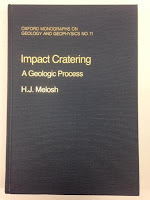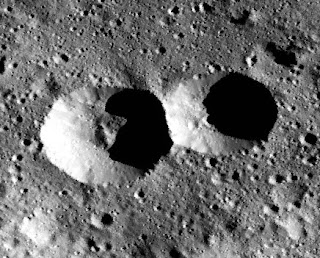Discerning Secondary Impacts from Primary Ones
 |
| Figure 1: He wrote the book |
A Fortunate Encounter
During the poster session at #LPSC2017, I was surprised and delighted that Jay Melosh stopped to discuss my poster on doublet craters. Not only had I cited some of his papers in my work, but he also "wrote the book" on Impact Cratering (no, really!).Dr. Melosh was genuinely interested, and also pleased to see that my co-author (and graduate advisor) was Ron Fevig, a former student of his at the Lunar and Planetary Laboratory at U of A.
After examining the images of potential doublets from my survey area,
 |
| Figure 2: Doublet crater on Ceres |
Refining Crater Identification Criteria
Moving into the next phase of my research, I need to be capable of identifying and eliminating secondary craters, since they are not the result of a binary asteroid impact. I should also note that multiple impacts are common among secondary craters, since a large number of secondary impactors are launched from the primary impact at the same time, and many are likely to land near each other.In my search for quantitative measures I could apply to this problem, I found a fairly recent paper by Fred Calef and colleagues which tackles the problem of differentiating secondary from primary impacts on Mars: Geomorphic analysis of small rayed craters on Mars:Examining primary versus secondary impacts. I will save a detailed overview of this paper for another time, but the most useful part for me came at the end: A table providing criteria for recognizing primary versus secondary craters on Mars (see Figure 3). I don't mean to imply that I could immediately apply these criteria to other bodies, but it should act as a model for me to create similar criteria for Ceres.
 |
| Figure 3: Criteria for recognizing secondary craters (Calef et al., 2009) |
References:
- Wren, P. F., & Fevig, R. A. (2017, March). Investigation of Doublet Craters on Ceres as Evidence of Main Belt Binary Asteroid Systems. In Lunar and Planetary Science Conference (Vol. 48). html
- Melosh, H. J. (1989). Impact cratering: A geologic process. Research supported by NASA. New York, Oxford University Press (Oxford Monographs on Geology and Geophysics, No. 11), 1989, 253 p., 11.
- Calef, F. J., Herrick, R. R., & Sharpton, V. L. (2009). Geomorphic analysis of small rayed craters on Mars: Examining primary versus secondary impacts. Journal of Geophysical Research: Planets, 114(E10). html


They offer every little thing from traditional on-line slots, to desk video games and more. New DraftKings customers who're minimal of|no much less than} 21 years old and 카지노사이트 in one of the DraftKings authorized states should deposit a minimum of $5 to their account when registering for the primary time. The deposit match bonus offer is eligible for redemption after a 15x play-through.
ReplyDelete